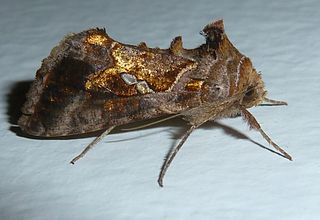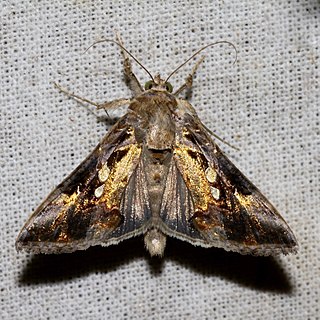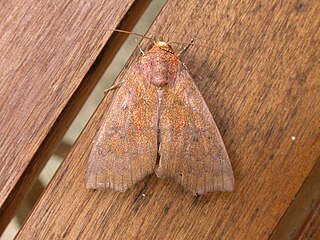
Chrysodeixis eriosoma, the green garden looper, known in New Zealand as the Silver Y, is a moth of the family Noctuidae. Mostly cosmopolitan in distribution, it is a pest in Japan, China, India, Sri Lanka, the Malay Peninsula and Australasia. It is present in Hawaii and recorded as an incursion in mainland North America and Russia. It is morphologically identical to Chrysodeixis chalcites and the two may be sibling species.

The tomato looper or golden twin-spot moth(Chrysodeixis chalcites) is a moth of the family Noctuidae, subfamily Plusiinae. It mainly lives in southern Europe, the Levant and tropical Africa, but can be seen migrating across much of Europe. In 2013, it was spotted in Canada. It is an important horticultural pest in New Zealand.

The Tobacco looper(Chrysodeixis argentifera) is a moth of the family Noctuidae. It is found in Australia and New Zealand.

Utetheisa pulchelloides, the heliotrope moth, is a moth of the family Erebidae. It is found in the Indo-Australian region including Borneo, Hong Kong, New Zealand, Papua, Seychelles, most of Australia,Tenerife and La Línea de la Concepción [Cádiz]. The species was first described by George Hampson in 1907.

Chrysodeixis is a genus of moths of the family Noctuidae described by Jacob Hübner in 1821.
Hypenagonia is a genus of moths of the family Erebidae first described by George Hampson in 1893. The adult moths have pale brown wings with a dark band across each wing. The wingspan of these moths is about 1 centimeter.

Targalla is a genus of moths of the family Euteliidae. The genus was erected by Francis Walker in 1858.

Comostola is a genus of moths in the family Geometridae erected by Edward Meyrick in 1888. They are found primarily in Asia and Australia.
Chrysodeixis diehli is a moth of the family Noctuidae. It is found throughout Sundaland.

Argyrogramma signata, the green semilooper, is a moth of the family Noctuidae.

Macaria abydata, commonly known as the dot-lined angle, is a moth of the family Geometridae. It is native from northern Argentina to the Caribbean and southern United States. It has been introduced to the Pacific and has spread rapidly since. The first introduction occurred in Hawaii in 1970. Further spread occurred as follows:

Hypocala deflorata is a moth of the family Erebidae. It was first described by Johan Christian Fabricius in 1794. It is widespread from India, Sri Lanka to Africa and to Australia and many Pacific islands. Records include China, Borneo, Queensland, Vanuatu, New Caledonia, Rotuma, Fiji, Samoa, Hawaii, Norfolk Island and New Zealand.

Polydesma boarmoides is a species of moth in the family Erebidae. It was first described by Achille Guenée in 1852. The species is found from the Indo-Australian tropics east from Sri Lanka, to Australia, Myanmar, Fiji and New Caledonia. It has also been recorded from the Marianas, Carolines, Society Islands and Hawaii.

Chasmina candida is a moth of the family Noctuidae described by Francis Walker in 1865. It is found from Indo-Australian tropics east to Fiji, including many islands of the Indian Ocean and Pacific.

Perixera obliviaria is a species of moth of the family Geometridae. It is found from the Indo-Australian tropics east to Queensland and Fiji.

Anomis nigritarsis is a species of moth of the family Erebidae. It is found in Sri Lanka, India, China (Hainan), Taiwan, Borneo, Java, Sulawesi, the Moluccas, Queensland, New Caledonia, the Solomon Islands, Vanuatu, Fiji, Samoa and Tonga.
Spiralisigna acidna is a moth in the family Geometridae. It is found in Australia and the south-western Pacific, including Fiji.

Maceda mansueta is a moth of the family Nolidae first described by Francis Walker in 1857. It is found in Japan, Sri Lanka, Borneo, India (Andamans), Malaysia, New Guinea, Fiji, Australia, Réunion and the Seychelles.














